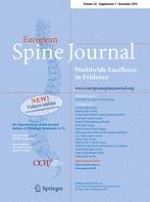01-11-2015 | Case Report
Finite element analysis and cadaveric cinematic analysis of fixation options for anteriorly implanted trabecular metal interbody cages
Published in: European Spine Journal | Special Issue 7/2015
Login to get accessAbstract
Purpose
To assess, with finite element analysis and an in vitro biomechanical study in cadaver, whether the implementation of an anterior interbody cage made of hedrocel with nitinol shape memory staples in compression increases the stiffness of the stand-alone interbody cage and to compare these constructs’ stiffness to other constructs common in clinical practice.
Methods
A biomechanical study with a finite element analysis and cadaveric testing assessed the stiffness of different fixation modes for the L4–L5 functional spinal unit: intact spine, destabilized spine with discectomy, posterior pedicle-screw fixation, anterior stand-alone interbody cage, anterior interbody cage with bilateral pedicle screws and anterior interbody cage with two shape memory staples in compression. These modalities of vertebral fixation were compared in four loading modes (flexion, extension, lateral bending, and axial rotation).
Results
The L4–L5 spinal unit with an anterior interbody cage and two staples was stiffer than the stand-alone cage. The construct stiffness was similar to that of a model of posterior pedicular stabilization. The stiffness was lower than that of the anterior cage plus bilateral pedicle-screw fixation.
Conclusion
The use of an anterior interbody implant with shape memory staples in compression may be an alternative to isolated posterior fixation and to anterior isolated implants, with increased stiffness.





